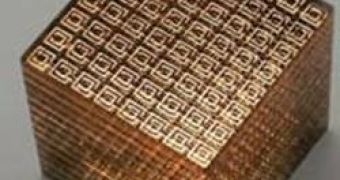All previous invisibility cloak projects claimed at some point in time that a three-dimensional optical light cloak can be built. I won't deny that this is true, although I haven't bumped into any invisible objects lately which leads me to believe that this attempt has failed. Now, a new three-dimensional optical cloak seems to be emerging from the University of California, but this time it's already built, although some remain skeptical towards its light bending capabilities.
Natural materials have position refraction index, meaning that when light passes through them it is bend at a certain angle. Artificial materials, such as metamaterials, on the other hand, can possess negative refraction indexes, meaning that light is bent around them making them invisible. The trouble with metamaterials is that they can only do so in a two dimensional environment, or at certain electromagnetic wavelengths.
Metamaterials interact with the electric and magnetic fields that compose light with the help of tiny periodic structures, smaller than the light waves. This basically means that the wavelength of light bent around the material is dependent on the technology used to create these structures. So far researchers have only been capable of creating structures small enough to work on long-wavelengths, such as microwaves.
The new three-dimensional metamaterial capable of achieving a negative refractive index in optical wavelengths has been developed by graduate student in nano-engineering, Jason Valentine from the University of California, and is said to contain 21 alternating layers of silver and magnesium fluoride in a fishnet structure. The 'prism', Valentine claims, is effective in the optical wavelengths of the near-infrared spectrum.
However, Gunnar Dolling from the University of Karlsruhe, who has designed a similar material, says that the claims made by Valentine are unrealistic, since the properties of the material were measured with the help of light bent backwards by the prism. According to Dolling, this method cannot ensure the accuracy of the true properties of the material and that the prism is in fact refracting light in an unusual way, giving the illusion of negative refractive index.
"You can only measure a negative refractive index by measuring the phase velocity", or the speed of light through the medium, Dolling said.

 14 DAY TRIAL //
14 DAY TRIAL //